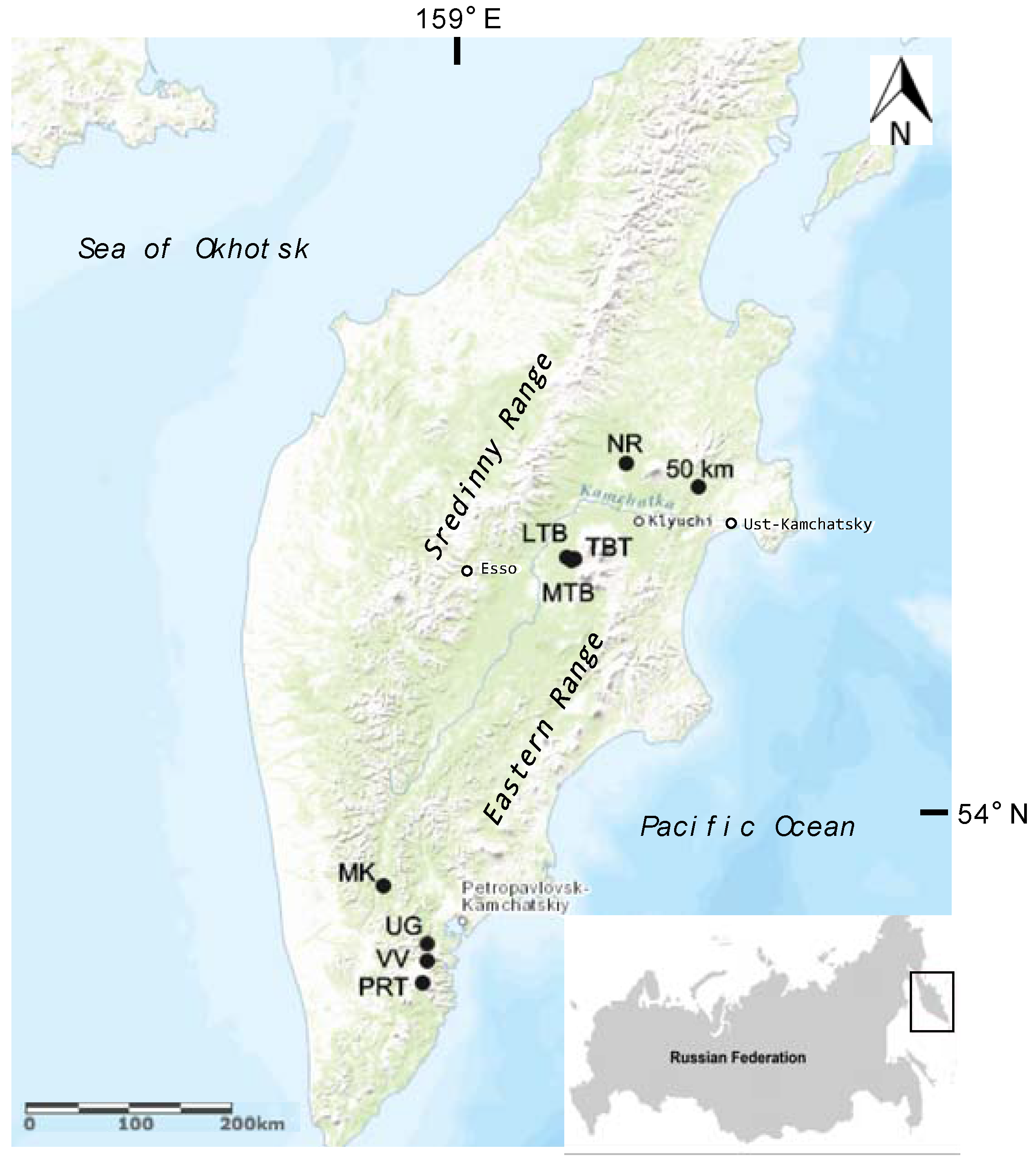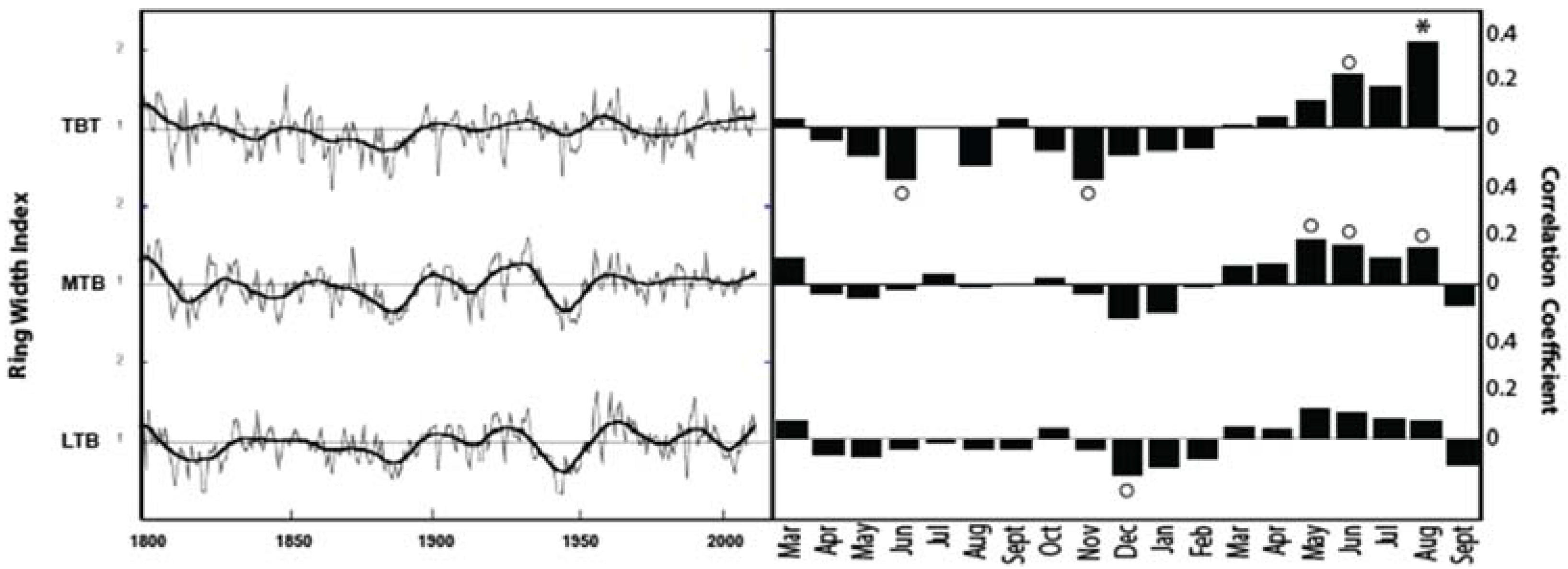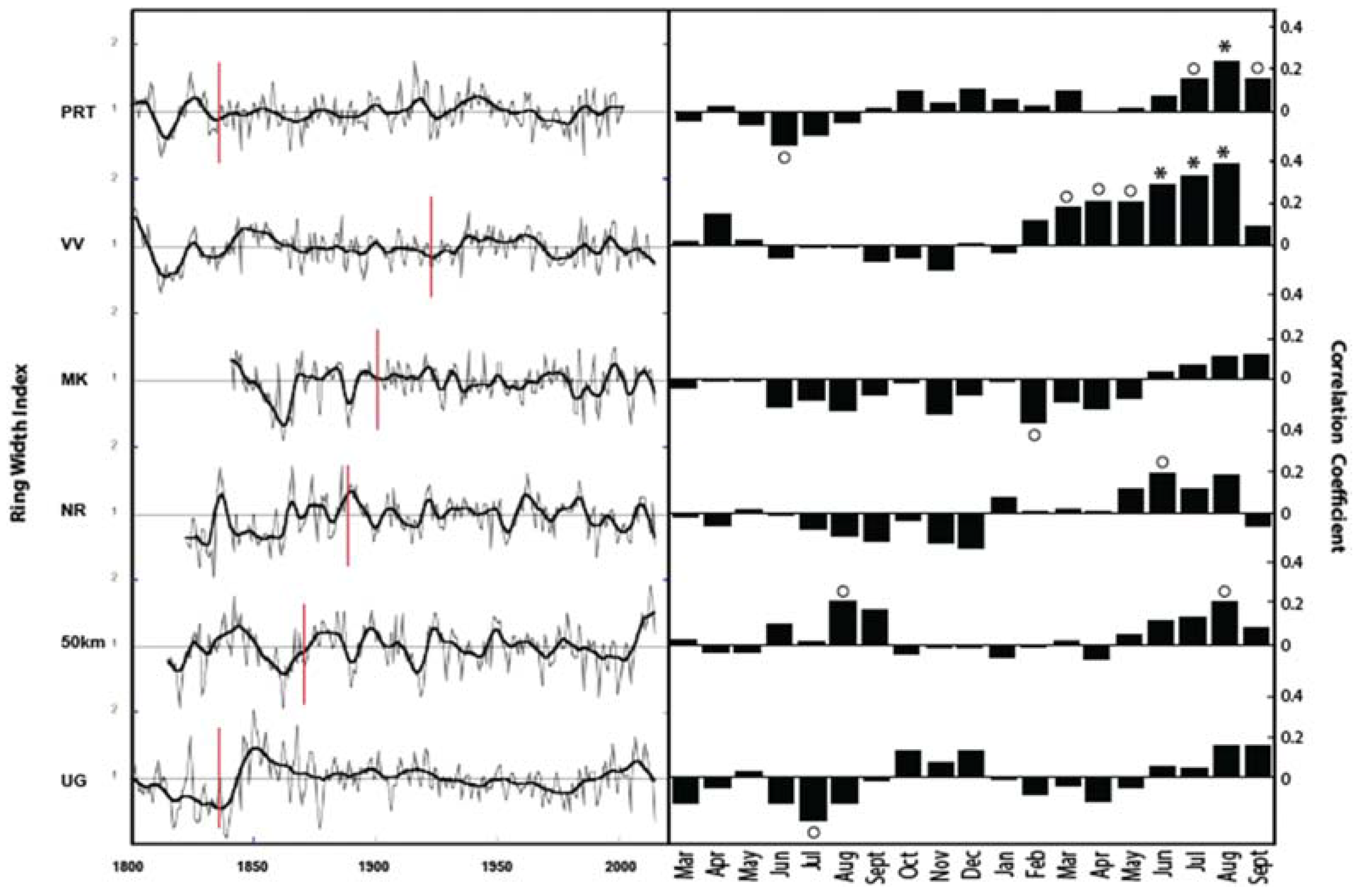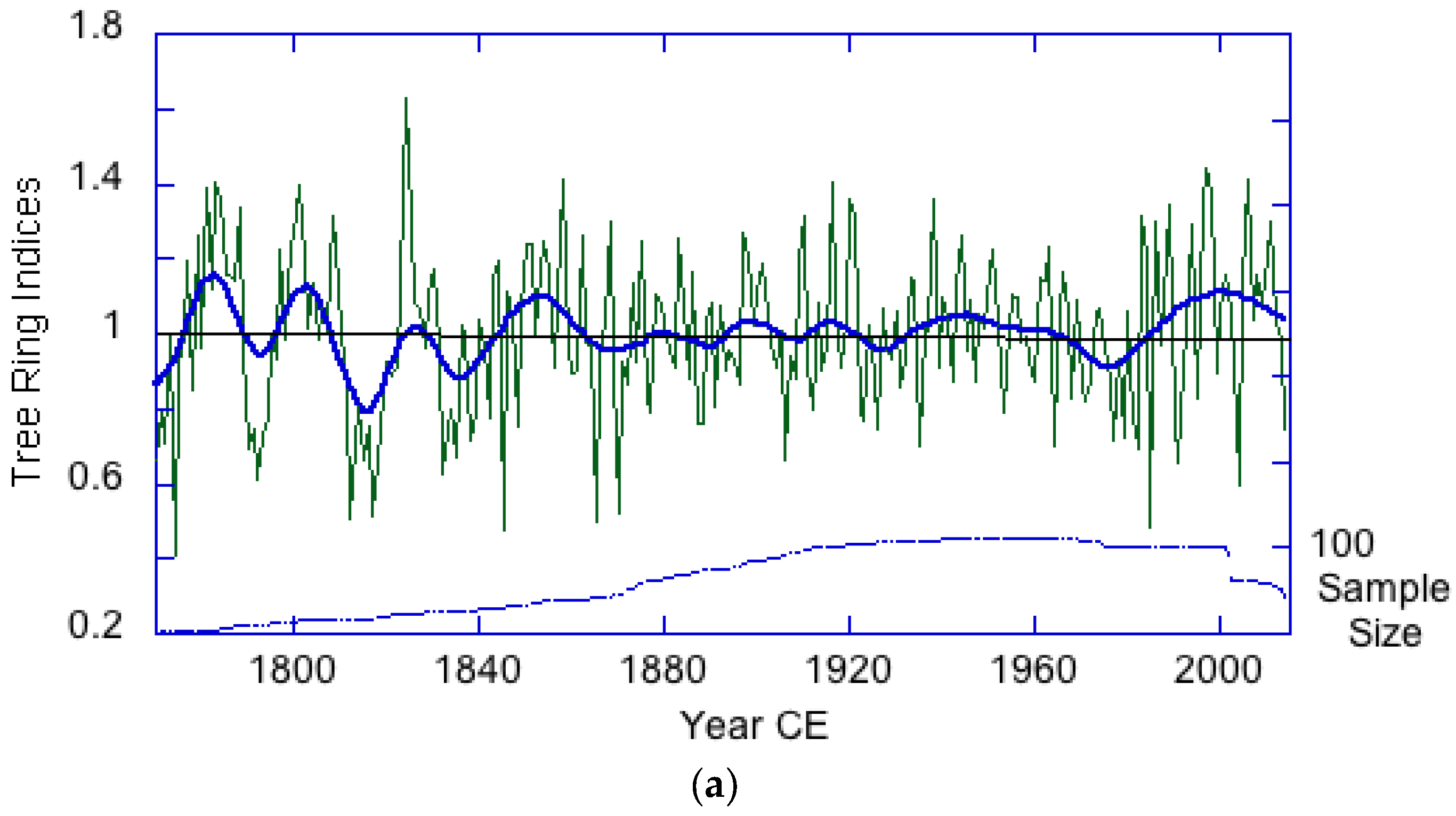Climate Response of Larch and Birch Forests across an Elevational Transect and Hemisphere-Wide Comparisons, Kamchatka Peninsula, Russian Far East
Abstract
:1. Introduction
2. Materials and Methods
3. Results
3.1. Stand Level Climate Signal
3.2. Regional and Hemispheric Climate Signals
4. Discussion
5. Conclusions
Acknowledgments
Author Contributions
Conflicts of Interest
References
- Sato, H.; Kobayashi, H.; Iwahana, G.; Ohta, T. Endurance of larch forest ecosystems in eastern Siberia under warming trends. Ecol. Evol. 2016, 6, 5690–5704. [Google Scholar] [CrossRef] [PubMed]
- Tchebakova, N.M.; Parfenova, E.; Soja, A.J. The effects of climate, permafrost and fire on vegetation change in Siberia in a changing climate. Environ. Res. Lett. 2009, 4, 045013. [Google Scholar] [CrossRef]
- Jones, V.; Solomina, O. The geography of Kamchatka. Glob. Planet. Chang. 2015, 134, 3–9. [Google Scholar] [CrossRef]
- Eichhorn, M. Boreal forests of Kamchatka: Structure and composition. Forests 2010, 1, 154–196. [Google Scholar] [CrossRef]
- Mock, C.J.; Bartlein, P.J.; Anderson, P.M. Atmospheric circulations patterns and climatic variations in Beringia. Int. J. Climatol. 1998, 10, 1085–1104. [Google Scholar] [CrossRef]
- Braitseva, O.A.; Ponomareva, V.V.; Sulerzhitsky, L.D.; Melekestev, I.V.; Bailey, J. Holocene Key-Marker Tephra Layers in Kamchatka, Russia. Quat. Res. 1997, 47, 125–139. [Google Scholar] [CrossRef]
- Wiles, G.C.; Solomina, O.; D’Arrigo, R.D.; Anchukaitis, K.; Gensiarovsky, Y.; Wiesenberg, N. Reconstructed Summer Temperatures over the Last 400 Years Based on larch ring widths: Sakhalin Island, Russian Far East. Clim. Dyn. 2015, 45, 397–405. [Google Scholar] [CrossRef]
- D’Arrigo, R.; Wilson, R.; Wiles, G.; Anchukaitis, K.; Solomina, O.; Davi, N.; Deser, C.; Dolgova, E. Tree ring reconstructed temperature index for coastal northern Japan: Implications for western North Pacific variability. Int. J. Climatol. 2014, 35, 3713–3720. [Google Scholar] [CrossRef]
- Gostev, M.; Wiles, G.; D’Arrigo, R.; Jacoby, G.; Khomentovsky, P. Early summer temperatures since 1670 A.D. for Central Kamchatka reconstructed based on a Siberian larch tree-ring width chronology. Can. J. For. Res. 1996, 26, 2048–2052. [Google Scholar] [CrossRef]
- Solomina, O.; Wiles, G.; Shiraiwa, T.; D’Arrigo, R. Multiproxy records of climate variability for Kamchatka for the past 400 years. Clim. Past Discuss. 2006, 2, 1051–1073. [Google Scholar]
- Sano, M.; Furuta, F.; Sweda, T. Summer temperature variations in southern Kamchatka as reconstructed from a 247-year tree-ring chronology of Betula ermanii. J. For. Res. 2010, 15, 234–240. [Google Scholar] [CrossRef]
- Takahashi, K.; Homma, K.; Shiraiwa, T.; Vetrova, P.V.; Hara, T. Climatic Factors Affecting the Growth of Larix cajanderi in the Kamchatka Peninsula, Russia. Eur. J. For. Res. 2001, 3, 1–9. [Google Scholar]
- Dolezal, J.; Ishii, H.; Takahaski, K.; Vetrova, V.P.; Homma, K.; Sumida, A.; Hara, T. Climatic factors affecting radial growth of Betula ermanii and Betula platypylla. Kamchatka. Can. J. For. Res. 2010, 40, 273–285. [Google Scholar] [CrossRef]
- Newell, J. The Russian Far East: A Reference Guide for Conservation and Development, 2nd ed.; Daniel & Daniel Publishers Inc.: McKinleyville, CA, USA, 2004; pp. 341–373. [Google Scholar]
- Solomina, O.; Pavlova, I.; Curtis, A.; Jacoby, G.; Ponomareva, V.; Pevzner, M. Constraining recent Shiveluch volcano eruptions (Kamchatka, Russia) by means of dendrochronology. Nat. Hazards Earth Syst. Sci. 2008, 8, 1083–1097. [Google Scholar] [CrossRef]
- Sano, M.; Furuta, F.; Sweda, T. Tree-ring-width chronology of Larix gmelinii as an indicator of changes in early summer temperature in east-central Kamchatka. J. For. Res. 2009, 14, 147–154. [Google Scholar] [CrossRef]
- Berner, L.T.; Beck, P.S.A.; Bunn, A.G.; Goetz, S.J. Plant response to climate change along the forest-tundra ecotone in northeastern Siberia. Glob. Chang. Biol. 2013, 19, 3449–3462. [Google Scholar] [CrossRef]
- Lloyd, A.H.; Bunn, A.G.; Berner, L.T. A latitudinal gradient in tree growth response to climate warming in the Siberian taiga. Glob. Chang. Biol. 2011, 17, 1935–1945. [Google Scholar] [CrossRef]
- Tei, S.; Sugimoto, A.; Yonenobu, H.; Matsuura, Y.; Osawa, A.; Sato, H.; Fujnuma, J.; Maximov, T. Tree-ring analysis and modeling approaches yield contrary response of circumboreal forest productivity to climate change. Glob. Chang. Biol. 2017, 1–10. [Google Scholar] [CrossRef] [PubMed]
- Wilson, R.; Anchukaitis, K.; Briffa, K.R.; Büntgen, U.; Cook, E.; D’Arrigo, R.; Davi, N.; Esper, J.; Frank, D.; Gunnarson, B.; et al. Last millennium northern hemisphere summer temperatures from tree rings: Part I: The long-term context. Quat. Sci. Rev. 2016, 134, 1–18. [Google Scholar] [CrossRef] [Green Version]
- Holmes, R.L. Computer-assisted quality control in tree-ring dating and measurement. Tree-Ring Bull. 1983, 43, 69–78. [Google Scholar]
- Grissino-Mayer, H. Evaluating crossdating accuracy: A manual and tutorial for the computer program COFECHA. Tree-Ring Res. 2001, 57, 205–221. [Google Scholar]
- Cook, E.R.; Holmes, R.L.; Adams, R.K.; Fritts, H.C. Users Manual for Program ARSTAN: Tree-Ring Chronologies of Western North America: California, Eastern Oregon and Northern Great Basin; Laboratory Tree Ring Research, The University of Arizona: Tucson, AZ, USA, 1986; pp. 50–65. [Google Scholar]
- GISTEMP Team. GISS Surface Temperature Analysis (GISTEMP). NASA Goddard Institute for Space Studies. Available online: http://data.giss.nasa.gov/gistemp/ (accessed on 15 June 2015).
- Hansen, J.; Ruedy, R.; Sato, M.; Lo, K. Global surface temperature change. Rev. Geophys. 2010, 48, 1–29. [Google Scholar] [CrossRef]
- Solomina, O.; Institute of Geography RAS, Moscow, Russia. Personal communication, 2015.
- Esper, J.; Cook, E.R.; Schweingruber, F.H. Low-frequency signals in long tree-ring chronologies for reconstructing past temperature variability. Science 2002, 295, 2250–2253. [Google Scholar] [CrossRef] [PubMed]
- Melvin, T.M.; Briffa, K.R. CRUST: Software for the implementation of Regional Chronology Standardisation: Part 1. Signal-free RCS. Dendrochronologia 2014, 32, 7–20. [Google Scholar] [CrossRef]
- Esper, J. Tests of the RCS method for preserving low-frequency variability in long tree-ring chronologies. Tree-Ring Res. 2003, 59, 81–98. [Google Scholar]
- Wigley, T.M.L.; Briffa, K.R.; Jones, P.D. On the average value of correlated time series, with applications in dendroclimatology and hydrometeorology. J. Clim. Appl. Meteorol. 1984, 23, 201–213. [Google Scholar] [CrossRef]
- Wilson, R.; Elling, W. Temporal instability in tree-growth/climate response in the Lower Bavarian Forest region: Implications for dendroclimatic reconstruction. Trees 2004, 18, 19–28. [Google Scholar] [CrossRef]
- Sigl, M.; Winstrup, M.; McConnell, J.R.; Welten, K.C.; Plunkett, G.; Ludlow, F.; Buntgen, U.; Caffee, M.; Chellman, N.; Dahl-Jensen, D. Timing and climate forcing of volcanic eruptions for the past 2500 years. Nature 2015, 523, 543–549. [Google Scholar] [CrossRef] [PubMed] [Green Version]
- Mosolov, V.I. Conservation of wild reindeer in Kamchatka. Rangifer 2000, 20, 95–98. [Google Scholar] [CrossRef]
- Dolezal, J.; Ishii, H.; Vetrova, V.P.; Sumida, A.; Hara, T. Tree growth and competition in a Betula platyphylla-Larix cajanderi post-fire forest in central Kamchatka. Ann. Bot. 2004, 94, 333–343. [Google Scholar] [CrossRef]
- Trouet, V.; Van Oldenborgh, G.H. KNMI Climate Explorer: A web-based research tool for high-resolution paleoclimatology. Tree-Ring Res. 2013, 69, 3–13. [Google Scholar] [CrossRef]
- Jarvis, S.K.; Wiles, G.C.; Appleton, S.N.; D’Arrigo, R.D.; Lawson, D.E. A warming-induced biome shift detected in tree growth of Mountain Hemlock (Tsuga mertensiana (Bong.) Carrière) along the Gulf of Alaska. Arct. Antarct. Alp. Res. 2013, 45, 211–218. [Google Scholar] [CrossRef]







| Site | Location | Altitude (m) | Species | Period of Record | Number of Cores/Trees |
|---|---|---|---|---|---|
| 54 km from Ust (50 km) | 56.52759° N, 161.97069° E | 112 | Betula ermanii | 1814–2014 (200 years) | 21/14 |
| North Road (NR) | 56.70416° N, 160.95035° E | 95–150 | Betula ermanii | 1823–2014 (191 years) | 21/16 |
| Lower Tobalchik Volcano (LTB) | 55.97215° N, 160.13524° E | 486 | Larix gmelinii | 1675–2014 (339 years) | 34/17 |
| Mid-Tobalchik Volcano (MTB) | 55.94931° N, 160.19910° E | 743 | Larix gmelinii | 1674–2014 (340 years) | 41/20 |
| Tobalchik Volcano (TBT) | 55.9567° N, 160.23132° E | 944 | Larix gmelinii | 1653–2014 (361 years) | 63/31 |
| Garchche Sopa (UG) | 52.8243° N, 158.1664° E | 68 | Betula ermanii | 1763–2014 (252 years) | 28/17 |
| Viluchi Volcano (VV) | 52.68926° N, 158.16354° E | 410 | Betula ermanii | 1792–2014 (223 years) | 22/13 |
| Malkee (MK) | 53.32233° N, 157.54709° E | 278 | Betula ermanii | 1841–2014 (173 years) | 23/13 |
| Paratunka * (PRT) | 52.50° N, 158.10° E | 864 | Betula ermanii | 1755–2014 (259 years) | 73/41 |
© 2017 by the authors. Licensee MDPI, Basel, Switzerland. This article is an open access article distributed under the terms and conditions of the Creative Commons Attribution (CC BY) license (http://creativecommons.org/licenses/by/4.0/).
Share and Cite
Deck, C.; Wiles, G.; Frederick, S.; Matsovsky, V.; Kuderina, T.; D’Arrigo, R.; Solomina, O.; Wiesenberg, N. Climate Response of Larch and Birch Forests across an Elevational Transect and Hemisphere-Wide Comparisons, Kamchatka Peninsula, Russian Far East. Forests 2017, 8, 315. https://doi.org/10.3390/f8090315
Deck C, Wiles G, Frederick S, Matsovsky V, Kuderina T, D’Arrigo R, Solomina O, Wiesenberg N. Climate Response of Larch and Birch Forests across an Elevational Transect and Hemisphere-Wide Comparisons, Kamchatka Peninsula, Russian Far East. Forests. 2017; 8(9):315. https://doi.org/10.3390/f8090315
Chicago/Turabian StyleDeck, Clara, Gregory Wiles, Sarah Frederick, Vladimir Matsovsky, Tatiana Kuderina, Rosanna D’Arrigo, Olga Solomina, and Nicholas Wiesenberg. 2017. "Climate Response of Larch and Birch Forests across an Elevational Transect and Hemisphere-Wide Comparisons, Kamchatka Peninsula, Russian Far East" Forests 8, no. 9: 315. https://doi.org/10.3390/f8090315





